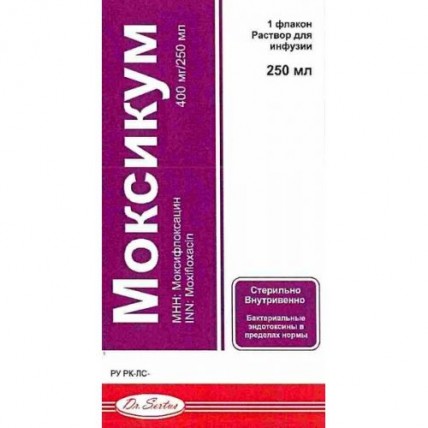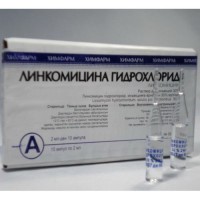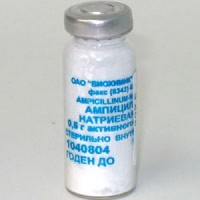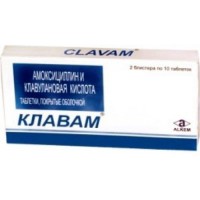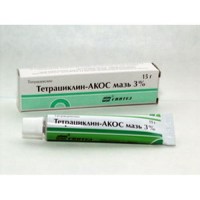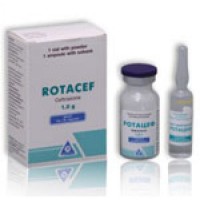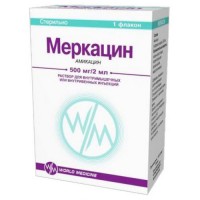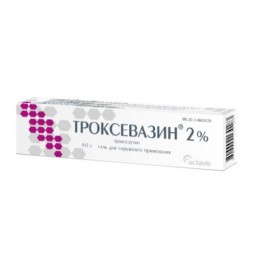Moksikum 400 mg / 250 ml solution for infusion 1's (vial)
- $52.00
The instruction for medical use
of Moksikum Torgovoye medicine a name
Moksikum
Mezhdunarodnoye the unlicensed
name Moxifloxacin Dosage Form Solution for infusions of 400 mg / 250 ml
Structure
One bottle contains
active agent - a moksifloksatsin a hydrochloride of 436.33 mg
(it is equivalent to a moksifloksatsin of 400.0 mg),
excipients: sodium chloride, 0.1 M acid of chlorohydrogen, 0.1 M of sodium hydroxide, water for injections.
The description
the Transparent solution of greenish yellow color almost free from particles.
Pharmacotherapeutic group
Antibacterial drugs for system use. Antimicrobial drugs derivative hinolona. Ftorkhinolona. Moxifloxacin.
The ATX J01MA14 code
the Pharmacological
Pharmacokinetics Absorption properties and bioavailability
After single infusion of Moksikum in a dose of 400 mg within 1 hour the maximum concentration of drug (Cmax) is reached at the end of infusion and makes about 4.1 mg/l that corresponds to its increase approximately by 26% in comparison with the size of this indicator at administration of drug inside. The drug exposure determined by AUC indicator (the area under a ratio curve concentration time) and equal 39 mg*ch/l, slightly exceeds that at administration of drug inside (35 mg*ch/l). The absolute bioavailability is about 91%.
There is no need for correction of a dose depending on a floor or age of the patient.
The pharmacokinetics is linear in doses from 50 to 1200 mg at oral administration, at single introduction up to 600 mg and at single introduction of doses up to 600 mg within 10 days.
Distribution
Moxifloxacin is very quickly distributed in the extravasated course. The volume of distribution is 2 l/kg. Linking with proteins of serum (mainly with albumine) blood in experiments of in vitro and ex vivo makes about 40 - 42% and does not depend on concentration of drug.
Moxifloxacin creates high concentrations in the following fabrics:
In 2.2 hours after oral reception of 5.4 mg/kg, 20.7 mg/l and 56.7 mg/l in mucous a bronchial tree, bronchoalveolar liquid and alveolar macrophages respectively.
In 10 hours after intravenous reception of 1.75 mg/l in skin.
In 1.8 h after intravenous reception of 1.0 mg/l in an interintercellular lymph.
Metabolism
After passing of the 2nd phase of biotransformation moxifloxacin is brought out of an organism by kidneys (about 40%) and a GIT (60%) both in not changed look, and in the form of inactive sulpho compounds (M1) and glucuronides (M2). Moxifloxacin is not exposed to biotransformation the microsomal system of P450 cytochrome.
Removal
Elimination half-life of drug makes about 12 hours of plasma. The general clearance of a moksifloksatsin after reception of a dose in 400 mg is from 179 to 246 ml/min.
After intravenous infusion of 400 mg of drug in not changed look 22% with urine and 26% with a stake are removed.
Renal clearance of 24-53 ml/min., way of a canalicular reabsorption.
Co-administration of ranitidine and a probenetsid does not break renal clearance of a moksifloksatsin.
Patients with a renal failure,
Pharmacokinetic properties of a moksifloksatsin do not change at patients with a renal failure (including patients with clearance of creatinine & gt, 20 ml/min. / 1.73 sq.m). In a renal failure the concentration of an inactive metabolite of M2 (glyukorunid) increases.
Patients with a liver failure
the Pharmacokinetics of drug is not broken in a liver failure. Slight increase of concentration of a metabolite of M1 in plasma is observed that has no clinical value.
A pharmacodynamics
Moksikum - bactericidal antibacterial drug of a broad spectrum of activity of a ftorkhinolonovy row. Inhibits topoisomerase II (DNK-giraza) and topoisomerase IV - the enzymes necessary for replication, a transcription, reparation and recombination of bacterial DNA.
Moxifloxacin has dose-dependent bactericidal effect.
The immunity to a moksifloksatsin develops slowly as a result of a number of consecutive mutations.
There is no cross resistance with penicillin, cephalosporins, aminoglycosides, macroleads and tetracyclines. Between drugs from group of ftorkhinolon the cross resistance can be observed.
Shows activity concerning a wide range of gram-positive and gram-negative microorganisms, anaerobic, acid resisting and atypical bacteria: Mycoplasma spp., Chlamydia spp., Legionella spp. It is effective concerning the bacterial strains resistant to a beta laktamnym to antibiotics and macroleads. It is active (as in vitro, and by results of clinical trials at treatment of a number of infections) concerning the majority of strains of the following microorganisms: aerobic gram-positive microorganisms - Enterococcus faecalis (only the strains sensitive to Vancomycinum and gentamycin), Staphylococcus aureus (only metitsillinochuvstvitelny strains), Streptococcus anginosus, Streptococcus constellatus, Streptococcuspneumoniae (including multi-drug resistant strains), Streptococcus pyogenes, aerobic gram-negative microorganisms - Enterobacter cloacae, Escherichia coli,
Haemophilus influenzae, Haemophilus parainfluenzae, Klebsiella pneumoniae, Moraxella catarrhalis, Proteusmirabilis, anaerobic microorganisms - Bacteroides fragilis, Bacteroides thetaiotaomicron, Clostridium perfringens, Peptostreptococcus spp. and also other microorganisms - Chlamydia pneumoniae, Mycoplasma pneumoniae.
According to in vitro of researches moxifloxacin is active concerning the majority (more than 90%) of strains of the following microorganisms: aerobic gram-positive microorganisms - Staphylococcus epidermidis (only metitsillinochuvstvitelny strains), Streptococcus agalactiae, Streptococcus viridans, aerobic gram-negative microorganisms - Citrobacter freundii, Klebsiella oxytoca, Legionella pneumophila, anaerobic microorganisms - Fusobacterium spp., Prevotella spp.
Indications
Moksikum solution for infusions is shown for treatment of the following bacterial infections caused by microorganisms, sensitive to drug:
- community-acquired pneumonia, including caused by multi-drug resistant
strains *
- the complicated infections of skin and soft tissues, including the infected
diabetic foot
- the complicated intraabdominal infections, including polymicrobial
infections, such as abscesses.
* Multi-drug resistant Streptococcus pneumoniae (MDRSP) includes the isolates known as PRSP (penicillin - resistant S. Pneumoniae) and the strains resistant to the following two and more antibiotics: penicillin (MIC & ge, 2 mkg/ml), the second generation of cephalosporins (for example, tsefuroksy), macroleads, tetracyclines and Trimethoprimum/sulfamethoxazole.
It is necessary to take official recommendations about appropriate use of antibacterial drugs into account.
The route of administration and doses
Adult
the Recommended mode of dosing Moksikuma for the listed above indications makes 400 mg once a day (250 ml of solution for infusions) and should not be exceeded.
Therapy duration
Duration of treatment is defined by weight of indications or clinical effect.
At the initial stages of treatment Moksikum solution can be applied to infusions, and then for continuation of therapy in the presence of clinical indications drug can be appointed inside in tablets.
Community-acquired pneumonia - the recommended general duration of treatment of step therapy (intravenous with the subsequent oral therapy) - 7-14 days.
The complicated infections of skin and soft tissues, including the infected
diabetic foot - the general duration of treatment of step therapy (intravenous with the subsequent oral therapy) - 7-21 days.
The complicated intraabdominal infections, including polymicrobial
infections, such as abscesses the general duration of treatment of step therapy (intravenous with the subsequent oral therapy) is 5-14 days.
It is not necessary to exceed the recommended treatment duration in 21 days.
To patients of advanced age, patients with insignificant abnormal liver functions and kidneys (including clearance of creatinine & le, 30 ml/min. / 1.73 sq.m) and also correction of the mode of dosing is not required to the patients who are on a continuous hemodialysis and long out-patient peritoneal dialysis.
Moksikum is not intended for use for children and teenagers up to 18 years.
Rules of use of solution for infusion
the Drug is administered intravenously in the form of infusion lasting not less than 60 minutes.
Rastvor Moksikuma it is possible to enter directly or through the T-shaped catheter with compatible solutions for infusions.
Solution mix Moksikuma with the infusion solutions given below remains stable within 24 hours at the room temperature in this connection they can be considered as solutions, compatible to Moksikum, for infusions.
Water for
Sodium injections chloride of 0.9%
of Sodium chloride 1 molar
Glucose of 5%
Glucose of 10%
Glucose of 40%
Xylitol of 20%
Ringera Rastvor Solution Ringera of a lactate
If Moksikum solution for infusions is appointed together with other drug, each drug should be administered separately.
As solution cannot be frozen or cooled, it cannot be stored in the fridge.
When cooling there can be a loss of a deposit which is dissolved at the room temperature.
Rastvor has to be stored in original packing.
It is necessary to enter only transparent solution.
Side effects
the Undesirable phenomena referred to category often were observed less than at 3% of patients, except nausea and diarrhea.
Often (& gt, 1/100 and 1/<, 10%)
- candidosis superinfections
- dizziness, a headache
- lengthening of an interval of QT on the ECG at patients with a hypopotassemia
- nausea, vomiting, an abdominal pain, diarrhea
- increase in level of transaminases in blood
- reactions on the place of an injection and infusion
Infrequently (& gt,/1,000 and & lt, 1/10%)
- anemia, a leukopenia, a neutropenia, a trobotsitopeniya, a thrombocytosis, lengthening of prothrombin time and increase in an indicator of the international normalized relation
- allergic reactions, urticaria, an itching, rash, an eosinophilia
- a lipidemia
- feeling of alarm, increase in psychomotor activity, agitation
- paresthesias / dizestezii
- taste disorders, including an ageusia (loss of flavoring sensitivity) seldom or never
- confusion of consciousness, a disorientation, sleep disorders, dizziness, a tremor, a somnolention
- disorders of vision, especially in combination with reactions from central nervous system
- lengthening of an interval of QT on the ECG at patients, heartbeat, tachycardia, a vazodilatation
- an asthma, including an asthmatic state
- a loss of appetite, a constipation, dyspepsia, a meteorism, a gastroenteritis (except an erosive gastroenteritis)
- increase in level of amylase, bilirubin, an abnormal liver function, including increase in level of a lactate dehydrogenase, increase in level gamma glutamiltransferazy and alkaline phosphatase
- an arthralgia, myalgia
- dehydration (caused by diarrhea or reduction of intake of liquid)
- the general malaise, pains of nonspecific character, perspiration
- thrombophlebitises on the place of infusion
is rare (& gt, 1/10 0000 and 1/1 000)
- change of concentration of thromboplastin
- anaphylactic/anaphylactoid reactions, allergic / Quincke's diseases, including a laryngeal edema (potentially life-threatening)
- a hyperglycemia, a hyperuricemia
- emotional lability, a depression (seldom or never potentially shown in behavior with a tendency to self-damage, such as suicide thoughts or attempts), hallucinations
- a giposteziya, disturbance of sense of smell, including an anosmia
- pathological dreams, a lack of coordination (including disturbances of gait mainly owing to dizziness or vertigo (leading to injuries as a result of falling, especially at elderly patients seldom or never), convulsive attacks with various clinical manifestations (including generalized), disturbances of attention, a speech disorder, amnesia
- a peripheral neuropathy and polyneuropathy
- sonitus, a hearing disorder, including deafness (usually reversible)
- faints, hypotension, hypertensia, ventricular tachyarrhythmias
- the dysphagy, stomatitises, the pseudomembranous colitis (associated with life-threatening complications seldom or never), jaundice, hepatitis (mainly cholestatic)
- tendonit, increase in a muscle tone and muscular spasms, weakness in muscles
- a renal failure, a renal failure (as a result of dehydration, especially at elderly patients with the accompanying renal failures)
- hypostases
Very seldom (& lt, 1/10,000)
- increase in concentration of a prothrombin and reduction of an indicator of the international normalized relation or change of concentration of a prothrombin and indicator of the international normalized relation.
- acute/anaphylactoid anaphylaxis (including potentially Criminal Investigation Department -
life zhayushchiya)
- the depersonalization, psychotic reactions which are potentially shown
in behavior with a tendency to self-damage
- a hyperesthesia
- a tranizitorny disorder of vision, especially in combination with reactions from central nervous system
- nonspecific arrhythmias (including premature ventricular contraction), polymorphic zhelu-
dochkovy tachycardia like pirouette, cardiac arrest, preimushchest-
venno at persons with the states contributing to arrhythmias, such as
clinically significant bradycardia, acute ischemia of a myocardium
- the lightning hepatitis which is potentially leading to a zhizneugrozhayushchy
liver failure including with a lethal outcome
- bullous skin reactions, for example, Stephens-Johnson's syndrome or
a toxic epidermal necrolysis (potentially life-threatening)
- ruptures of sinews, arthritises, gait disorders owing to myshech-
ny, tendinous or articulate damages, aggravation of symptoms
of a myasthenia Gravis
Sleduyushchiye the undesirable phenomena were observed in subgroup of the patients who were on step therapy of a solution/tablet by Moksikum:
Often
- increase in level gamma glutamil transferases
Infrequently
- ventricular tachyarrhythmias, arterial hypotension, hypostases, the pseudomembranous colitis caused by antibiotics (seldom or never associated with life-threatening complications), convulsive attacks with various clinical manifestations (including generalizshchovanny), hallucinations, a renal failure and a renal failure (as a result of dehydration, especially at elderly patients with the accompanying renal failures).
Contraindications
- hypersensitivity to drug components
- pregnancy and a lactation (breastfeeding)
- children's and teenage age up to 18 years
- the congenital or acquired lengthening of an interval of QT
- disturbance of balance of electrolytes, most often an uncontrollable hypopotassemia
- clinically significant bradycardia
- clinically significant heart failure with the reduced fraction of emission of a left ventricle.
Moksikum should not be used with the drugs extending QT interval.
Medicinal interactions
Moksikum's use with such drugs QT extending an interval as is contraindicated:
- antiarrhytmic drugs IA of a class (quinidine, hydroquinidine, disopiramid).
- antiarrhytmic drugs III of a class (Amiodaronum, sotalol, dofetilid, ibutilid).
- anti-psychotics (fenotiazina, Pimozidum, sertindol, haloperidol, sultoprid).
- tricyclic antidepressants.
- some antimicrobial drugs (sakvinavir, sparfloksatsin, erythromycin in/in, some antimalarial drugs).
- some antihistaminic drugs (terfenadin, astemizol, mizolastin).
- others (tsisaprid, Vincaminum in/in, bepridit, diphenaminum).
Moksikum has to be applied with care with the drugs lowering potassium level (for example, loopback and thiazide diuretics, laxatives, corticosteroids, Amphotericinum B) and drugs capable to cause delay of a warm rhythm (bradycardia).
When assigning repeated doses of drug along with digoxin at healthy faces, the maximum concentration of digoxin increased approximately by 30%, at the same time a ratio the area under a curve concentration time (AUC) and the minimum concentration of digoxin do not change.
Despite decrease in concentration of glibenclamide by 21% at a concomitant use with moksifloksatsiny, changes in glucose level in blood were not observed. Correction of a dosage at combined use with glibenclamide is not required.
Correction of a dosage at combined use with atenolol, ranitidine, calcium - the containing additives, theophylline, oral contraceptive means, itrakonazoly, cyclosporine, morphine, probenitsidy is not required.
Absorption of drug does not change at a concomitant use of food (including dairy products). Moksikum it is possible to apply irrespective of meal.
Incompatibility
With Moksikum the following solutions are incompatible:
solution of sodium of chloride of 10% and 20%
solution of Natrii hydrocarbonas of 4.2% and 8.4%
Special instructions
Moxifloxacin can extend QT interval at some patients. Extent of lengthening is connected with increase in level of drug in blood during fast intravenous infusion.
Treatment moksifloksatsiny has to be stopped in case of developing of arrhythmia.
Moxifloxacin has to be applied with care at patients with a predrasplozhennost to arrhythmias (for example, acute ischemia of a myocardium).
Moxifloxacin has to be applied with care with the drugs which are perhaps influencing potassium level in blood.
Moxifloxacin has to be applied with care with the drugs which are perhaps causing bradycardia.
At women and elderly patients the risk of emergence of lengthening of an interval of QT is slightly higher, it needs to be considered when assigning a moksifloksatsin.
In certain cases after the first use of drug the hypersensitivity and allergic reactions can develop what it is necessary to inform the doctor immediately on.
Very seldom anaphylactic reactions can progress to a life-threatening acute anaphylaxis, in certain cases after the first use of drug. In these cases Moksikum it is necessary to cancel and hold necessary treatment (including antishock).
Cases of developing of fulminantny hepatitis against the background of reception of a moksifloksatsin are described. In case of emergence in patients of such symptoms as jaundice (and the related asthenia), darkening of color of urine, tendency to bleedings, hepatic encephalopathy it is necessary to stop use of drug and to perform comprehensive examination of a liver.
At use of hinolon, including a moksifloksatsina it was reported about the cases of development of touch and sensomotor polyneuropathy leading to paresthesia, a gipoesteziya, a dysesthesia or weakness. At development of symptoms of neuropathy, such as pain, burning, pricking, numbness or weakness it is necessary to consult the patients who are on treatment by Moksikum immediately with the doctor before continuing treatment.
Mental reactions can appear even after the first use of drugs of a ftorkhinolonovy row, including Moksikum.
If at the patient the specified reactions develop it is necessary to stop treatment by Moksikum and to take the appropriate measures. It is recommended to be careful when using drug at psychotic patients or at patients who in the anamnesis have a psychiatric disease.
Use of drugs of a hinolonovy row is accompanied by possible risk of developing a convulsive attack. Moksikum it is necessary to apply with care at patients with diseases of central nervous system and with the states suspicious concerning involvement of central nervous system contributing to developing of convulsive attacks or reducing a threshold of convulsive activity.
Cases of emergence of inflammation and a rupture of sinews are described (especially Achilles) at use of ftorkhinolon (including a moksifloksatsina). The risk of emergence of similar states increases at elderly patients at a concomitant use with corticosteroids.
It was reported about cases of development of bullous skin reactions, for example, of Stephens-Johnson's syndrome or a toxic epidermal necrolysis (potentially life-threatening). At emergence of reactions from skin and/or mucous membranes it is also necessary to consult immediately with the doctor before continuing treatment.
As use of antibacterial drugs of a broad spectrum of activity, including Moksikum, is accompanied by risk of developing the pseudomembranous colitis associated with reception of antibiotics, this diagnosis should be meant at patients at whom against the background of drug treatment the heavy diarrhea is observed. In this case the corresponding therapy immediately has to be appointed. The drugs inhibiting an intestines vermicular movement are contraindicated to patients at whom heavy diarrhea is observed.
Moksikum it is necessary to use with care at patients with a myasthenia as drug can aggravate symptoms of this disease.
At use of a moksifloksatsin in practice reactions of photosensitivity were not noted. Nevertheless, the patients receiving moxifloxacin have to avoid direct sunshine and UF - radiation.
Use of a moksifloksatsin in MRSA infections is not recommended (Methicillinum - resistant golden staphylococcus). In these cases it is necessary to appoint adequate antibacterial therapy.
Use in pediatrics
the Efficiency and safety of drug at children and teenagers aged up to 18 years is not established.
Pregnancy and the period of a lactation
Safety of use of drug at pregnancy is not established therefore its use is contraindicated.
A small amount of a moksifloksatsin is distinguished with breast milk therefore in need of prescribing of drug in the period of a lactation it is necessary to stop breastfeeding.
Features of influence of medicine on ability to run motor transport and potentially dangerous mechanisms.
Drug can cause side reactions from the central nervous system therefore the possibility of driving and other mechanisms is defined proceeding from assessment of reaction of the patient to administration of drug.
Overdose
Symptoms - single doses up to 1200 mg and repeated doses on 600 mg within 10 days were appointed to healthy people and were not followed by any side effects.
Treatment - in case of overdose it is necessary to be guided by a clinical picture and to carry out symptomatic maintenance therapy with ECG monitoring.
The form of release and packing
Solution for infusions place the colourless glass bottle like I in 250 ml corked by a bromobutilkauchukovy stopper and the combined cap from aluminum like Flip off.
1 bottle, together with the instruction for medical use in the state and Russian languages place in a cardboard box.
To Store storage conditions at a temperature not over 25C.
To store out of children's reach!
Period of storage
3 years.
Not to apply on expiry date.
Prescription status
According to the prescription
the Producer Mefar Ilach Sanayi A.Sh., Turkey
the Address: Istanbul. Ramazanolu Makh. Ensar Dzhad. No. 20. Kurtkyoy-Pendik. Turkey
Owner of the registration certificate
Doctor of Sertus Ilach Sanayi Ve Tidzharet Limited Shirketi, Turkey
Address: 34212 Evren Makhallesi, Dzhami Yolu Dzhaddesi No. 50. Girish Kat. Gyuneshli. Bagdzhylar. Istanbul. Turkey
the Name, the address and a contact information (phone, the fax, electronic mails) the organizations of the claim (offer) on quality of medicines accepting in the territory of the Republic of Kazakhstan from consumers and responsible for post-registration observation of safety of medicine.
TROKA-S PHARMA LLP, Almaty, Suyunbaya Avenue 222-b
ph. 8+7 727 251 99 35, +7 727 251 99 45
fax: 8+7 727 252 90 90 +7 701 786 33 98 (24-hour access)
to Develop
of Moksikum Torgovoye medicine a name
Moksikum
Mezhdunarodnoye the unlicensed
name Moxifloxacin Dosage Form Solution for infusions of 400 mg / 250 ml
Structure
One bottle contains
active agent - a moksifloksatsin a hydrochloride of 436.33 mg
(it is equivalent to a moksifloksatsin of 400.0 mg),
excipients: sodium chloride, 0.1 M acid of chlorohydrogen, 0.1 M of sodium hydroxide, water for injections.
The description
the Transparent solution of greenish yellow color almost free from particles.
Pharmacotherapeutic group
Antibacterial drugs for system use. Antimicrobial drugs derivative hinolona. Ftorkhinolona. Moxifloxacin.
The ATX J01MA14 code
the Pharmacological
Pharmacokinetics Absorption properties and bioavailability
After single infusion of Moksikum in a dose of 400 mg within 1 hour the maximum concentration of drug (Cmax) is reached at the end of infusion and makes about 4.1 mg/l that corresponds to its increase approximately by 26% in comparison with the size of this indicator at administration of drug inside. The drug exposure determined by AUC indicator (the area under a ratio curve concentration time) and equal 39 mg*ch/l, slightly exceeds that at administration of drug inside (35 mg*ch/l). The absolute bioavailability is about 91%.
There is no need for correction of a dose depending on a floor or age of the patient.
The pharmacokinetics is linear in doses from 50 to 1200 mg at oral administration, at single introduction up to 600 mg and at single introduction of doses up to 600 mg within 10 days.
Distribution
Moxifloxacin is very quickly distributed in the extravasated course. The volume of distribution is 2 l/kg. Linking with proteins of serum (mainly with albumine) blood in experiments of in vitro and ex vivo makes about 40 - 42% and does not depend on concentration of drug.
Moxifloxacin creates high concentrations in the following fabrics:
In 2.2 hours after oral reception of 5.4 mg/kg, 20.7 mg/l and 56.7 mg/l in mucous a bronchial tree, bronchoalveolar liquid and alveolar macrophages respectively.
In 10 hours after intravenous reception of 1.75 mg/l in skin.
In 1.8 h after intravenous reception of 1.0 mg/l in an interintercellular lymph.
Metabolism
After passing of the 2nd phase of biotransformation moxifloxacin is brought out of an organism by kidneys (about 40%) and a GIT (60%) both in not changed look, and in the form of inactive sulpho compounds (M1) and glucuronides (M2). Moxifloxacin is not exposed to biotransformation the microsomal system of P450 cytochrome.
Removal
Elimination half-life of drug makes about 12 hours of plasma. The general clearance of a moksifloksatsin after reception of a dose in 400 mg is from 179 to 246 ml/min.
After intravenous infusion of 400 mg of drug in not changed look 22% with urine and 26% with a stake are removed.
Renal clearance of 24-53 ml/min., way of a canalicular reabsorption.
Co-administration of ranitidine and a probenetsid does not break renal clearance of a moksifloksatsin.
Patients with a renal failure,
Pharmacokinetic properties of a moksifloksatsin do not change at patients with a renal failure (including patients with clearance of creatinine & gt, 20 ml/min. / 1.73 sq.m). In a renal failure the concentration of an inactive metabolite of M2 (glyukorunid) increases.
Patients with a liver failure
the Pharmacokinetics of drug is not broken in a liver failure. Slight increase of concentration of a metabolite of M1 in plasma is observed that has no clinical value.
A pharmacodynamics
Moksikum - bactericidal antibacterial drug of a broad spectrum of activity of a ftorkhinolonovy row. Inhibits topoisomerase II (DNK-giraza) and topoisomerase IV - the enzymes necessary for replication, a transcription, reparation and recombination of bacterial DNA.
Moxifloxacin has dose-dependent bactericidal effect.
The immunity to a moksifloksatsin develops slowly as a result of a number of consecutive mutations.
There is no cross resistance with penicillin, cephalosporins, aminoglycosides, macroleads and tetracyclines. Between drugs from group of ftorkhinolon the cross resistance can be observed.
Shows activity concerning a wide range of gram-positive and gram-negative microorganisms, anaerobic, acid resisting and atypical bacteria: Mycoplasma spp., Chlamydia spp., Legionella spp. It is effective concerning the bacterial strains resistant to a beta laktamnym to antibiotics and macroleads. It is active (as in vitro, and by results of clinical trials at treatment of a number of infections) concerning the majority of strains of the following microorganisms: aerobic gram-positive microorganisms - Enterococcus faecalis (only the strains sensitive to Vancomycinum and gentamycin), Staphylococcus aureus (only metitsillinochuvstvitelny strains), Streptococcus anginosus, Streptococcus constellatus, Streptococcuspneumoniae (including multi-drug resistant strains), Streptococcus pyogenes, aerobic gram-negative microorganisms - Enterobacter cloacae, Escherichia coli,
Haemophilus influenzae, Haemophilus parainfluenzae, Klebsiella pneumoniae, Moraxella catarrhalis, Proteusmirabilis, anaerobic microorganisms - Bacteroides fragilis, Bacteroides thetaiotaomicron, Clostridium perfringens, Peptostreptococcus spp. and also other microorganisms - Chlamydia pneumoniae, Mycoplasma pneumoniae.
According to in vitro of researches moxifloxacin is active concerning the majority (more than 90%) of strains of the following microorganisms: aerobic gram-positive microorganisms - Staphylococcus epidermidis (only metitsillinochuvstvitelny strains), Streptococcus agalactiae, Streptococcus viridans, aerobic gram-negative microorganisms - Citrobacter freundii, Klebsiella oxytoca, Legionella pneumophila, anaerobic microorganisms - Fusobacterium spp., Prevotella spp.
Indications
Moksikum solution for infusions is shown for treatment of the following bacterial infections caused by microorganisms, sensitive to drug:
- community-acquired pneumonia, including caused by multi-drug resistant
strains *
- the complicated infections of skin and soft tissues, including the infected
diabetic foot
- the complicated intraabdominal infections, including polymicrobial
infections, such as abscesses.
* Multi-drug resistant Streptococcus pneumoniae (MDRSP) includes the isolates known as PRSP (penicillin - resistant S. Pneumoniae) and the strains resistant to the following two and more antibiotics: penicillin (MIC & ge, 2 mkg/ml), the second generation of cephalosporins (for example, tsefuroksy), macroleads, tetracyclines and Trimethoprimum/sulfamethoxazole.
It is necessary to take official recommendations about appropriate use of antibacterial drugs into account.
The route of administration and doses
Adult
the Recommended mode of dosing Moksikuma for the listed above indications makes 400 mg once a day (250 ml of solution for infusions) and should not be exceeded.
Therapy duration
Duration of treatment is defined by weight of indications or clinical effect.
At the initial stages of treatment Moksikum solution can be applied to infusions, and then for continuation of therapy in the presence of clinical indications drug can be appointed inside in tablets.
Community-acquired pneumonia - the recommended general duration of treatment of step therapy (intravenous with the subsequent oral therapy) - 7-14 days.
The complicated infections of skin and soft tissues, including the infected
diabetic foot - the general duration of treatment of step therapy (intravenous with the subsequent oral therapy) - 7-21 days.
The complicated intraabdominal infections, including polymicrobial
infections, such as abscesses the general duration of treatment of step therapy (intravenous with the subsequent oral therapy) is 5-14 days.
It is not necessary to exceed the recommended treatment duration in 21 days.
To patients of advanced age, patients with insignificant abnormal liver functions and kidneys (including clearance of creatinine & le, 30 ml/min. / 1.73 sq.m) and also correction of the mode of dosing is not required to the patients who are on a continuous hemodialysis and long out-patient peritoneal dialysis.
Moksikum is not intended for use for children and teenagers up to 18 years.
Rules of use of solution for infusion
the Drug is administered intravenously in the form of infusion lasting not less than 60 minutes.
Rastvor Moksikuma it is possible to enter directly or through the T-shaped catheter with compatible solutions for infusions.
Solution mix Moksikuma with the infusion solutions given below remains stable within 24 hours at the room temperature in this connection they can be considered as solutions, compatible to Moksikum, for infusions.
Water for
Sodium injections chloride of 0.9%
of Sodium chloride 1 molar
Glucose of 5%
Glucose of 10%
Glucose of 40%
Xylitol of 20%
Ringera Rastvor Solution Ringera of a lactate
If Moksikum solution for infusions is appointed together with other drug, each drug should be administered separately.
As solution cannot be frozen or cooled, it cannot be stored in the fridge.
When cooling there can be a loss of a deposit which is dissolved at the room temperature.
Rastvor has to be stored in original packing.
It is necessary to enter only transparent solution.
Side effects
the Undesirable phenomena referred to category often were observed less than at 3% of patients, except nausea and diarrhea.
Often (& gt, 1/100 and 1/<, 10%)
- candidosis superinfections
- dizziness, a headache
- lengthening of an interval of QT on the ECG at patients with a hypopotassemia
- nausea, vomiting, an abdominal pain, diarrhea
- increase in level of transaminases in blood
- reactions on the place of an injection and infusion
Infrequently (& gt,/1,000 and & lt, 1/10%)
- anemia, a leukopenia, a neutropenia, a trobotsitopeniya, a thrombocytosis, lengthening of prothrombin time and increase in an indicator of the international normalized relation
- allergic reactions, urticaria, an itching, rash, an eosinophilia
- a lipidemia
- feeling of alarm, increase in psychomotor activity, agitation
- paresthesias / dizestezii
- taste disorders, including an ageusia (loss of flavoring sensitivity) seldom or never
- confusion of consciousness, a disorientation, sleep disorders, dizziness, a tremor, a somnolention
- disorders of vision, especially in combination with reactions from central nervous system
- lengthening of an interval of QT on the ECG at patients, heartbeat, tachycardia, a vazodilatation
- an asthma, including an asthmatic state
- a loss of appetite, a constipation, dyspepsia, a meteorism, a gastroenteritis (except an erosive gastroenteritis)
- increase in level of amylase, bilirubin, an abnormal liver function, including increase in level of a lactate dehydrogenase, increase in level gamma glutamiltransferazy and alkaline phosphatase
- an arthralgia, myalgia
- dehydration (caused by diarrhea or reduction of intake of liquid)
- the general malaise, pains of nonspecific character, perspiration
- thrombophlebitises on the place of infusion
is rare (& gt, 1/10 0000 and 1/1 000)
- change of concentration of thromboplastin
- anaphylactic/anaphylactoid reactions, allergic / Quincke's diseases, including a laryngeal edema (potentially life-threatening)
- a hyperglycemia, a hyperuricemia
- emotional lability, a depression (seldom or never potentially shown in behavior with a tendency to self-damage, such as suicide thoughts or attempts), hallucinations
- a giposteziya, disturbance of sense of smell, including an anosmia
- pathological dreams, a lack of coordination (including disturbances of gait mainly owing to dizziness or vertigo (leading to injuries as a result of falling, especially at elderly patients seldom or never), convulsive attacks with various clinical manifestations (including generalized), disturbances of attention, a speech disorder, amnesia
- a peripheral neuropathy and polyneuropathy
- sonitus, a hearing disorder, including deafness (usually reversible)
- faints, hypotension, hypertensia, ventricular tachyarrhythmias
- the dysphagy, stomatitises, the pseudomembranous colitis (associated with life-threatening complications seldom or never), jaundice, hepatitis (mainly cholestatic)
- tendonit, increase in a muscle tone and muscular spasms, weakness in muscles
- a renal failure, a renal failure (as a result of dehydration, especially at elderly patients with the accompanying renal failures)
- hypostases
Very seldom (& lt, 1/10,000)
- increase in concentration of a prothrombin and reduction of an indicator of the international normalized relation or change of concentration of a prothrombin and indicator of the international normalized relation.
- acute/anaphylactoid anaphylaxis (including potentially Criminal Investigation Department -
life zhayushchiya)
- the depersonalization, psychotic reactions which are potentially shown
in behavior with a tendency to self-damage
- a hyperesthesia
- a tranizitorny disorder of vision, especially in combination with reactions from central nervous system
- nonspecific arrhythmias (including premature ventricular contraction), polymorphic zhelu-
dochkovy tachycardia like pirouette, cardiac arrest, preimushchest-
venno at persons with the states contributing to arrhythmias, such as
clinically significant bradycardia, acute ischemia of a myocardium
- the lightning hepatitis which is potentially leading to a zhizneugrozhayushchy
liver failure including with a lethal outcome
- bullous skin reactions, for example, Stephens-Johnson's syndrome or
a toxic epidermal necrolysis (potentially life-threatening)
- ruptures of sinews, arthritises, gait disorders owing to myshech-
ny, tendinous or articulate damages, aggravation of symptoms
of a myasthenia Gravis
Sleduyushchiye the undesirable phenomena were observed in subgroup of the patients who were on step therapy of a solution/tablet by Moksikum:
Often
- increase in level gamma glutamil transferases
Infrequently
- ventricular tachyarrhythmias, arterial hypotension, hypostases, the pseudomembranous colitis caused by antibiotics (seldom or never associated with life-threatening complications), convulsive attacks with various clinical manifestations (including generalizshchovanny), hallucinations, a renal failure and a renal failure (as a result of dehydration, especially at elderly patients with the accompanying renal failures).
Contraindications
- hypersensitivity to drug components
- pregnancy and a lactation (breastfeeding)
- children's and teenage age up to 18 years
- the congenital or acquired lengthening of an interval of QT
- disturbance of balance of electrolytes, most often an uncontrollable hypopotassemia
- clinically significant bradycardia
- clinically significant heart failure with the reduced fraction of emission of a left ventricle.
Moksikum should not be used with the drugs extending QT interval.
Medicinal interactions
Moksikum's use with such drugs QT extending an interval as is contraindicated:
- antiarrhytmic drugs IA of a class (quinidine, hydroquinidine, disopiramid).
- antiarrhytmic drugs III of a class (Amiodaronum, sotalol, dofetilid, ibutilid).
- anti-psychotics (fenotiazina, Pimozidum, sertindol, haloperidol, sultoprid).
- tricyclic antidepressants.
- some antimicrobial drugs (sakvinavir, sparfloksatsin, erythromycin in/in, some antimalarial drugs).
- some antihistaminic drugs (terfenadin, astemizol, mizolastin).
- others (tsisaprid, Vincaminum in/in, bepridit, diphenaminum).
Moksikum has to be applied with care with the drugs lowering potassium level (for example, loopback and thiazide diuretics, laxatives, corticosteroids, Amphotericinum B) and drugs capable to cause delay of a warm rhythm (bradycardia).
When assigning repeated doses of drug along with digoxin at healthy faces, the maximum concentration of digoxin increased approximately by 30%, at the same time a ratio the area under a curve concentration time (AUC) and the minimum concentration of digoxin do not change.
Despite decrease in concentration of glibenclamide by 21% at a concomitant use with moksifloksatsiny, changes in glucose level in blood were not observed. Correction of a dosage at combined use with glibenclamide is not required.
Correction of a dosage at combined use with atenolol, ranitidine, calcium - the containing additives, theophylline, oral contraceptive means, itrakonazoly, cyclosporine, morphine, probenitsidy is not required.
Absorption of drug does not change at a concomitant use of food (including dairy products). Moksikum it is possible to apply irrespective of meal.
Incompatibility
With Moksikum the following solutions are incompatible:
solution of sodium of chloride of 10% and 20%
solution of Natrii hydrocarbonas of 4.2% and 8.4%
Special instructions
Moxifloxacin can extend QT interval at some patients. Extent of lengthening is connected with increase in level of drug in blood during fast intravenous infusion.
Treatment moksifloksatsiny has to be stopped in case of developing of arrhythmia.
Moxifloxacin has to be applied with care at patients with a predrasplozhennost to arrhythmias (for example, acute ischemia of a myocardium).
Moxifloxacin has to be applied with care with the drugs which are perhaps influencing potassium level in blood.
Moxifloxacin has to be applied with care with the drugs which are perhaps causing bradycardia.
At women and elderly patients the risk of emergence of lengthening of an interval of QT is slightly higher, it needs to be considered when assigning a moksifloksatsin.
In certain cases after the first use of drug the hypersensitivity and allergic reactions can develop what it is necessary to inform the doctor immediately on.
Very seldom anaphylactic reactions can progress to a life-threatening acute anaphylaxis, in certain cases after the first use of drug. In these cases Moksikum it is necessary to cancel and hold necessary treatment (including antishock).
Cases of developing of fulminantny hepatitis against the background of reception of a moksifloksatsin are described. In case of emergence in patients of such symptoms as jaundice (and the related asthenia), darkening of color of urine, tendency to bleedings, hepatic encephalopathy it is necessary to stop use of drug and to perform comprehensive examination of a liver.
At use of hinolon, including a moksifloksatsina it was reported about the cases of development of touch and sensomotor polyneuropathy leading to paresthesia, a gipoesteziya, a dysesthesia or weakness. At development of symptoms of neuropathy, such as pain, burning, pricking, numbness or weakness it is necessary to consult the patients who are on treatment by Moksikum immediately with the doctor before continuing treatment.
Mental reactions can appear even after the first use of drugs of a ftorkhinolonovy row, including Moksikum.
If at the patient the specified reactions develop it is necessary to stop treatment by Moksikum and to take the appropriate measures. It is recommended to be careful when using drug at psychotic patients or at patients who in the anamnesis have a psychiatric disease.
Use of drugs of a hinolonovy row is accompanied by possible risk of developing a convulsive attack. Moksikum it is necessary to apply with care at patients with diseases of central nervous system and with the states suspicious concerning involvement of central nervous system contributing to developing of convulsive attacks or reducing a threshold of convulsive activity.
Cases of emergence of inflammation and a rupture of sinews are described (especially Achilles) at use of ftorkhinolon (including a moksifloksatsina). The risk of emergence of similar states increases at elderly patients at a concomitant use with corticosteroids.
It was reported about cases of development of bullous skin reactions, for example, of Stephens-Johnson's syndrome or a toxic epidermal necrolysis (potentially life-threatening). At emergence of reactions from skin and/or mucous membranes it is also necessary to consult immediately with the doctor before continuing treatment.
As use of antibacterial drugs of a broad spectrum of activity, including Moksikum, is accompanied by risk of developing the pseudomembranous colitis associated with reception of antibiotics, this diagnosis should be meant at patients at whom against the background of drug treatment the heavy diarrhea is observed. In this case the corresponding therapy immediately has to be appointed. The drugs inhibiting an intestines vermicular movement are contraindicated to patients at whom heavy diarrhea is observed.
Moksikum it is necessary to use with care at patients with a myasthenia as drug can aggravate symptoms of this disease.
At use of a moksifloksatsin in practice reactions of photosensitivity were not noted. Nevertheless, the patients receiving moxifloxacin have to avoid direct sunshine and UF - radiation.
Use of a moksifloksatsin in MRSA infections is not recommended (Methicillinum - resistant golden staphylococcus). In these cases it is necessary to appoint adequate antibacterial therapy.
Use in pediatrics
the Efficiency and safety of drug at children and teenagers aged up to 18 years is not established.
Pregnancy and the period of a lactation
Safety of use of drug at pregnancy is not established therefore its use is contraindicated.
A small amount of a moksifloksatsin is distinguished with breast milk therefore in need of prescribing of drug in the period of a lactation it is necessary to stop breastfeeding.
Features of influence of medicine on ability to run motor transport and potentially dangerous mechanisms.
Drug can cause side reactions from the central nervous system therefore the possibility of driving and other mechanisms is defined proceeding from assessment of reaction of the patient to administration of drug.
Overdose
Symptoms - single doses up to 1200 mg and repeated doses on 600 mg within 10 days were appointed to healthy people and were not followed by any side effects.
Treatment - in case of overdose it is necessary to be guided by a clinical picture and to carry out symptomatic maintenance therapy with ECG monitoring.
The form of release and packing
Solution for infusions place the colourless glass bottle like I in 250 ml corked by a bromobutilkauchukovy stopper and the combined cap from aluminum like Flip off.
1 bottle, together with the instruction for medical use in the state and Russian languages place in a cardboard box.
To Store storage conditions at a temperature not over 25C.
To store out of children's reach!
Period of storage
3 years.
Not to apply on expiry date.
Prescription status
According to the prescription
the Producer Mefar Ilach Sanayi A.Sh., Turkey
the Address: Istanbul. Ramazanolu Makh. Ensar Dzhad. No. 20. Kurtkyoy-Pendik. Turkey
Owner of the registration certificate
Doctor of Sertus Ilach Sanayi Ve Tidzharet Limited Shirketi, Turkey
Address: 34212 Evren Makhallesi, Dzhami Yolu Dzhaddesi No. 50. Girish Kat. Gyuneshli. Bagdzhylar. Istanbul. Turkey
the Name, the address and a contact information (phone, the fax, electronic mails) the organizations of the claim (offer) on quality of medicines accepting in the territory of the Republic of Kazakhstan from consumers and responsible for post-registration observation of safety of medicine.
TROKA-S PHARMA LLP, Almaty, Suyunbaya Avenue 222-b
ph. 8+7 727 251 99 35, +7 727 251 99 45
fax: 8+7 727 252 90 90 +7 701 786 33 98 (24-hour access)
to Develop
